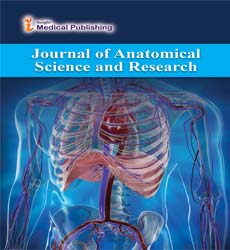Age-related Histological Changes in Human Cardiac Tissue: A Comparative Analysis
Isabella Rossi*
Department of Biomedical Sciences, University of Milan, Milan, Italy
*Corresponding Author:
Isabella Rossi,
Department of Biomedical Sciences, University of Milan, Milan, Italy,
E-mail: isabella.rossi@nii.it
Received date: February 03, 2025; Accepted date: February 05, 2025; Published date: February 28, 2025
Citation: Rossi I (2025) Age-related Histological Changes in Human Cardiac Tissue: A Comparative Analysis. J Anat Sci Res Vol: 8 No: 01: 04
Introduction
The human heart is a highly specialized organ that undergoes continuous structural and functional adaptations throughout the lifespan. While cardiac performance is preserved remarkably well in healthy individuals, the aging process inevitably induces histological changes in myocardial tissue that contribute to altered function, increased susceptibility to disease, and reduced capacity for repair. A comparative analysis of cardiac histology across different age groups provides valuable insights into the pathophysiological mechanisms of aging and helps to distinguish normal senescent changes from those associated with cardiovascular disease. One of the earliest histological alterations observed with advancing age is cardiomyocyte hypertrophy. Unlike many tissues, the adult heart has a very limited capacity for cell proliferation; instead, cardiomyocytes enlarge to compensate for the gradual loss of contractile cells. Histological studies demonstrate an increase in myocyte diameter and nuclear size in elderly hearts compared to younger ones. While this adaptation maintains contractile strength, it also increases myocardial stiffness, predisposing to diastolic dysfunction [1].
Description
Parallel to cellular hypertrophy, there is a progressive decline in cardiomyocyte number due to apoptosis and necrosis. Post-mortem studies estimate a loss of nearly 30â??35% of ventricular myocytes between the third and ninth decades of life. This reduction is particularly evident in the left ventricle, where functional demands are greatest. Fewer cardiomyocytes mean increased workload on surviving cells, further exacerbating hypertrophy and contributing to structural remodeling. Another hallmark of cardiac aging is the accumulation of interstitial fibrosis. Histological staining reveals increased deposition of collagen types I and III in the extracellular matrix, particularly in the interstitial and perivascular regions. Fibrotic remodeling stiffens the myocardium, impairs electrical conduction, and elevates the risk of arrhythmias. Unlike adaptive hypertrophy, fibrosis is largely maladaptive, reducing compliance and interfering with normal systolic and diastolic function [2].
The microvasculature of the heart also undergoes age-related changes. Capillary density declines with advancing age, impairing oxygen delivery to hypertrophied cardiomyocytes. Endothelial dysfunction, thickening of capillary basement membranes, and arteriosclerotic changes in intramural coronary arteries further compromise myocardial perfusion. These changes increase vulnerability to ischemia, even in the absence of overt coronary artery disease [3].
Histological evaluation also reveals lipofuscin accumulation within aging cardiomyocytes. Lipofuscin, a pigment formed from oxidized proteins and lipids, appears as yellow-brown granules in the cytoplasm. While considered a marker of cellular aging rather than a direct cause of dysfunction, excessive accumulation reflects oxidative stress and impaired autophagic clearance, both of which are prominent features of aged myocardium. The conduction system of the heart shows specific degenerative changes with aging. Fibrosis and fatty infiltration of the sinoatrial and atrioventricular nodes, along with loss of specialized pacemaker cells, contribute to bradyarrhythmias and conduction delays. Histologically, these changes correlate with the higher prevalence of atrial fibrillation, bundle branch blocks, and sick sinus syndrome in elderly populations [4].
At the subcellular level, mitochondrial dysfunction becomes evident in aged cardiac tissue. Mitochondria in elderly hearts show structural abnormalities such as swelling, disrupted cristae, and accumulation of mitochondrial DNA mutations. These changes compromise ATP production and increase reactive oxygen species (ROS) generation, further damaging cellular components and amplifying the cycle of oxidative stress. Aging also affects the valvular structures of the heart. Histological studies demonstrate progressive thickening and calcification of valve leaflets, especially in the aortic and mitral valves. These changes stem from increased extracellular matrix deposition, collagen cross-linking, and calcium phosphate accumulation. Clinically, such histological alterations manifest as valvular sclerosis and stenosis, common in older adults. Comparative studies across age groups highlight that while many histological changes are gradual and adaptive in early stages, they become maladaptive with advancing age [5].
Conclusion
Age-related histological changes in human cardiac tissue represent a complex interplay of cellular hypertrophy, myocyte loss, interstitial fibrosis, vascular remodeling, lipofuscin accumulation, and mitochondrial dysfunction. While some changes serve compensatory roles, others progressively impair cardiac performance and increase vulnerability to arrhythmias, ischemia, and heart failure. A comparative analysis across age groups reveals the gradual transition from adaptive remodeling to pathological degeneration. By elucidating these microscopic changes, clinicians and researchers gain essential insight into the mechanisms of cardiac aging, paving the way for preventive and therapeutic strategies aimed at preserving heart health in the aging population.
Acknowledgement
None.
Conflict of Interest
None.
References
- Karppi J, Laukkanen JA, Mäkikallio TH, Ronkainen K, Kurl, S. (2012). Low β-carotene concentrations increase the risk of cardiovascular disease mortality among Finnish men with risk factors. Nutr Metab Cardiovasc Dis22: 921-928.
Google Scholar Cross Ref Indexed at
- Karppi J, Laukkanen JA, Mäkikallio TH, Ronkainen K, Kurl S. (2013). Serum β-carotene and the risk of sudden cardiac death in men: A population-based follow-up study. Atheroscler226: 172-177.
Google Scholar Cross Ref Indexed at
- Aggarwal BB, Harikumar KB. (2009). Potential therapeutic effects of curcumin, the anti-inflammatory agent, against neurodegenerative, cardiovascular, pulmonary, metabolic, autoimmune and neoplastic diseases. Int J Biochem Cell Biol41: 40-59.
Google Scholar Cross Ref Indexed at
- Wongcharoen W, Phrommintikul A. (2009). The protective role of curcumin in cardiovascular diseases. Int J Cardiol133: 145-151.
Google Scholar Cross Ref Indexed at
- Duan W, Yang Y, Yan J, Yu S, Liu J, et al. (2012). The effects of curcumin post-treatment against myocardial ischemia and reperfusion by activation of the JAK2/STAT3 signaling pathway. Basic Res Cardiol107: 263.
Open Access Journals
- Aquaculture & Veterinary Science
- Chemistry & Chemical Sciences
- Clinical Sciences
- Engineering
- General Science
- Genetics & Molecular Biology
- Health Care & Nursing
- Immunology & Microbiology
- Materials Science
- Mathematics & Physics
- Medical Sciences
- Neurology & Psychiatry
- Oncology & Cancer Science
- Pharmaceutical Sciences
